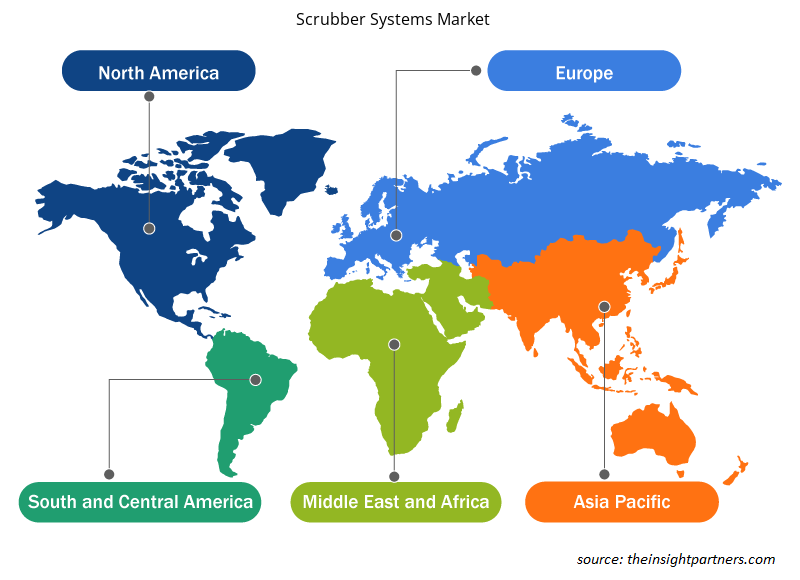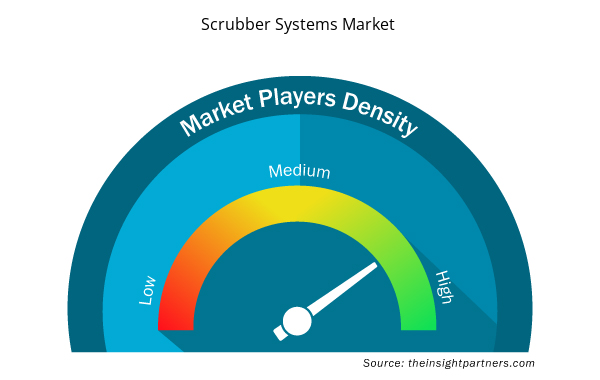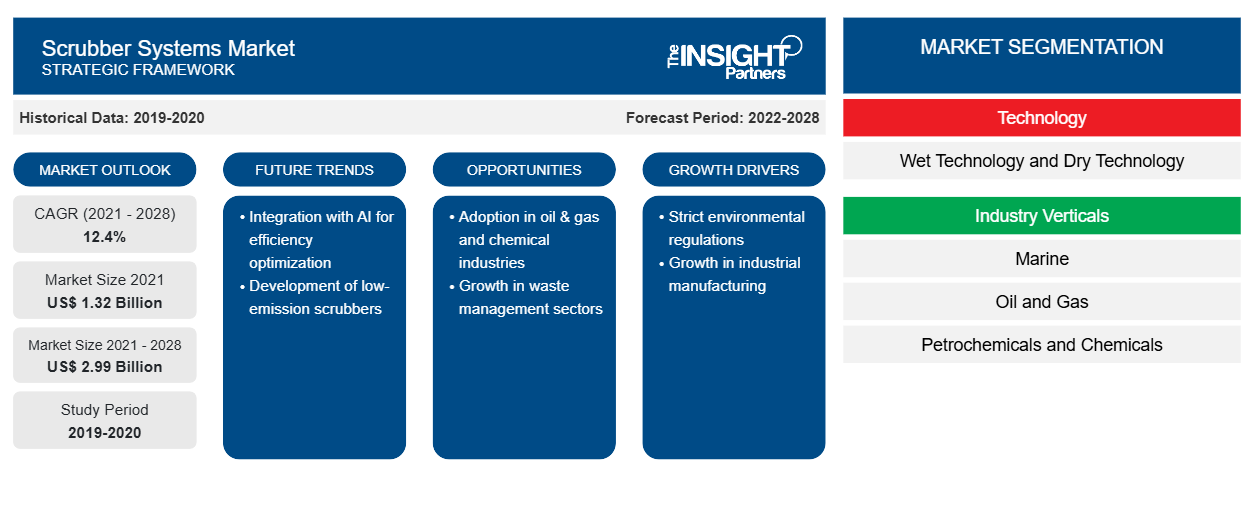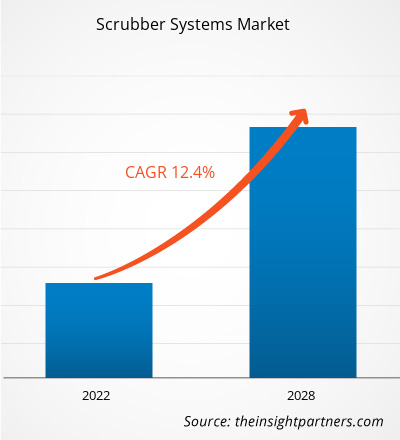2021 年洗涤器系统市场价值为 13.16 亿美元,预计到 2028 年将达到 29.892 亿美元;预计 2021 年至 2028 年的复合年增长率为 12.4%。
众所周知,水泥、玻璃、化工和石化、食品和农业以及制药等主要制造业都会排放有害气体。因此,对这些行业实施的严格环境法规正在推动市场发展。例如,水泥行业是主要污染行业之一,因为它在生产过程中会释放二氧化氮 (NO2) 和二氧化硫 (SO2) 颗粒物。此外,通过海上航线进行的国际贸易的增加和休闲活动的增多推动了洗涤器系统市场的增长。全球海运业务的增长可归因于其经济的运输成本以及全球对商品和石油产品的需求不断增长。此外,邮轮度假和国际航行等休闲活动的参与度不断提高,也促进了船舶的使用,进而推动了洗涤器系统市场的增长。
COVID-19 疫情对洗涤器系统市场的影响
在全球疫情爆发后,突如其来的新冠肺炎疫情对洗涤器系统行业的需求产生了重大负面影响。2020 年 8 月,作为船用洗涤器领域的领先企业之一,Yara Marine Technologies 因新冠肺炎疫情和低油价将重点从市场转移。该公司创新经理表示,他们对 2020 年的洗涤器系统寄予厚望,但新冠肺炎疫情改变了这一切。然而,由于多国政府出台了严格的法规来保持空气清洁,市场需求从第三季度开始上升。空气洗涤器系统在去除废气中的有害颗粒方面发挥着至关重要的作用,支持市场恢复增长势头。
定制此报告以满足您的需求
您可以免费定制任何报告,包括本报告的部分内容、国家级分析、Excel 数据包,以及为初创企业和大学提供优惠和折扣
- 获取此报告的关键市场趋势。这个免费样品将包括数据分析,从市场趋势到估计和预测。
市场洞察 –
洗涤器系统市场
全球海上贸易和休闲活动增加
通过海上航线进行的国际贸易不断增加,休闲活动也日益增多,推动了洗涤器系统市场的增长。全球海运业务的增长可以归因于其经济的运输成本和全球对商品和石油产品的需求不断增长。此外,游轮度假和国际航行等休闲活动的参与度不断提高,增加了船舶的使用,从而推动了洗涤器系统市场的增长。休闲活动的增加可以归因于消费者人均收入的增加。因此,由于全球贸易蓬勃发展,船舶硫排放量增加,以及发展中和发达经济体海上运输的不断升级,正在推动洗涤器系统的安装。
基于技术的见解
根据技术,洗涤器系统市场分为湿式技术和干式技术。湿式技术部分在 2021 年占据了更大的市场份额。
洗涤器系统市场的参与者主要专注于开发先进、高效的产品。
- 2021年7月,巴布科克·威尔科克斯环境公司宣布将支持阿迈厄资源中心申请在丹麦哥本哈根ARC的阿迈厄-巴克(Copenhill)废物能源转化设施建设先进的二氧化碳捕获设施,投资额超过1.4亿美元。
- 2021 年 9 月,杜邦清洁技术公司为其硫磺回收装置 (SRU) 应用中的 MECS DynaWave 洗涤器推出了创新且先进的蒸汽羽流抑制解决方案。Sennuba 可在洗涤系统中提供可靠的腐蚀控制和羽流抑制,同时最大程度地降低堵塞风险。
洗涤器系统市场区域洞察
Insight Partners 的分析师已详尽解释了预测期内影响洗涤器系统市场的区域趋势和因素。本节还讨论了北美、欧洲、亚太地区、中东和非洲以及南美和中美洲的洗涤器系统市场细分和地理位置。

- 获取洗涤器系统市场的区域特定数据
洗涤器系统市场报告范围
| 报告属性 | 细节 |
|---|---|
| 2021 年市场规模 | 13.2亿美元 |
| 2028 年市场规模 | 29.9 亿美元 |
| 全球复合年增长率(2021 - 2028) | 12.4% |
| 史料 | 2019-2020 |
| 预测期 | 2022-2028 |
| 涵盖的领域 | 按技术分类
|
| 覆盖地区和国家 | 北美
|
| 市场领导者和主要公司简介 |
|
洗涤器系统市场参与者密度:了解其对业务动态的影响
洗涤器系统市场正在快速增长,这得益于最终用户需求的不断增长,这些需求源于消费者偏好的不断变化、技术进步以及对产品优势的认识不断提高等因素。随着需求的增加,企业正在扩大其产品范围,进行创新以满足消费者的需求,并利用新兴趋势,从而进一步推动市场增长。
市场参与者密度是指在特定市场或行业内运营的企业或公司的分布情况。它表明在给定市场空间中,相对于其规模或总市场价值,有多少竞争对手(市场参与者)存在。
在洗涤器系统市场运营的主要公司有:
- 巴布科克和威尔科克斯企业有限公司
- 阿法拉伐
- 杜邦公司
- 富士电机株式会社
- 基伊埃集团
免责声明:上面列出的公司没有按照任何特定顺序排列。

- 获取洗涤器系统市场顶级关键参与者概览
洗涤器系统市场细分如下:
洗涤器系统市场 – 按技术分类
洗涤器系统市场 – 按垂直行业划分
- 海洋
- 石油和天然气
- 石油化工和化学品
- 食品和农业
- 废水处理
- 卫生保健
- 其他的
洗涤器系统市场——按地区划分
- 北美
- 我们
- 加拿大
- 墨西哥
- 欧洲
- 德国
- 法国
- 意大利
- 英国
- 俄罗斯
- 欧洲其他地区
- 亚太地区 (APAC)
- 中国
- 印度
- 日本
- 韩国
- 泰国
- 亚太地区其他地区
- 中东和非洲
- 南非
- MEA 其他地区
- 南美洲
- 巴西
- 阿根廷
- SAM 其余部分
洗涤器系统市场 – 公司简介
- 巴布科克和威尔科克斯企业有限公司
- 阿法拉伐
- 杜邦公司
- 富士电机株式会社
- 基伊埃集团
- 瓦锡兰公司
- 阿蒙
- 雅苒船舶技术
- Verantis 环境解决方案集团
- CECO环境
- 历史分析(2 年)、基准年、预测(7 年)及复合年增长率
- PEST 和 SWOT 分析
- 市场规模价值/数量 - 全球、区域、国家
- 行业和竞争格局
- Excel 数据集


- Bathroom Vanities Market
- Medical Devices Market
- Nuclear Waste Management System Market
- Diaper Packaging Machine Market
- Railway Braking System Market
- Emergency Department Information System (EDIS) Market
- 3D Audio Market
- Volumetric Video Market
- Electronic Signature Software Market
- Electronic Toll Collection System Market

Report Coverage
Revenue forecast, Company Analysis, Industry landscape, Growth factors, and Trends

Segment Covered
This text is related
to segments covered.

Regional Scope
North America, Europe, Asia Pacific, Middle East & Africa, South & Central America

Country Scope
This text is related
to country scope.
常见问题
The scrubber system market in Europe is sub-segmented into France, Germany, Russia, Italy, the UK, and the Rest of Europe. Compared with the Nordic and Eastern European countries, western European countries are more developed and technologically advanced. EU is increasingly stringent policies to observe the numerous constituents of air which is anticipated to propel the growth of the scrubber system market. Also, despite the EU proposals, all member states of the IMO again approved scrubbing system technology as an accepted compliance method. According to European exports, Germany is one of the essential countries for deploying marine scrubbers in long voyage vessels.
The rising application of sulfur dioxide (SOx) removal scrubber technology in the marine industry has gained significant traction in recent years. It is expected to propel the growth of the scrubber system market in the coming years. The SOx removal scrubber technology offers three different scrubber technology variants based on the vessel's operating profile, such as open-loop scrubber technology, closed-loop scrubber technology, and hybrid scrubber technology. The open-loop scrubber technology uses seawater to scrub the exhaust gas. It discharges the sulfuric acid content water back into the sea as the natural alkalinity of seawater neutralizes the acid.
Marine segment of the scrubber system market comprises ship industries including passenger and cargo. Marine segment holds the largest revenue of the scrubber system market and anticipated to maintain its dominance in the coming years. The growth of the segment can be attributed to the rising stringent policies for the ship industry. For instance, In January 2020, International Maritime Organization (IMO) has changed the emission rules and limits the sulphur in the fuel oil used on board ships operating outside designated emission control areas to 0.5% m/m (mass by mass) previously the limit was 3.5%. Similarly, within specific designated emission control areas the limits are 0.1% m/m.
The wet technology segment of the scrubber system market is poised to grow with significant during the estimated period. The growth of the segment can be attributed to its large application in a wide range of industries such as oil and gas, petrochemicals, marine, wastewater treatment, electronics and semiconductor, and others. For instance, CECO Environmental Corp. is providing CECO HEE-Duall Scrubber (a wet scrubber system) to leading global semiconductor chip manufacturers for removing harmful gaseous contaminants. The technology facilitates an efficient air pollution control methods for eliminating particles as well as gases from industrial exhaust streams. The Wet scrubber technology are considered the most appropriate device for air pollution control which collects both gas and particulates in a single system.
Major manufacturing industries such as cement, glass, chemical and petrochemical, food and agriculture, and pharmaceuticals are known for harmful gas emissions. Hence, the stringent environmental regulations on these industries are driving the market. For instance, the cement industry is one of the major polluting industries as it releases nitrogen dioxide (NO2) and sulfur dioxide (SO2) particulate during production.
The rapid industrialization in developing economies is creating a lucrative opportunity for scrubber system manufacturers to augment their market share further. The growing industrial activities in developing economies such as China, India, Brazil, and Vietnam result in more establishments of plants and factories of various industries. In this rapid industrialization era, the developing economies are witnessing a surge in new production facilities or capacities of the manufacturing industries such as cement, glass, petrochemicals and chemicals, oil & gas, food & beverages, pharmaceuticals, mining & metallurgy, and pulp & paper. For instance, China's National Bureau of Statistics (NBS) has reported a 1.6% year-on-year rise in cement production to 2.377 billion tons for 2020. Also, the country is witnessing constructions of 3,203 cement factory projects, which started in December 2020, with a total investment of US$ 415.6 billion.
Trends and growth analysis reports related to Electronics and Semiconductor : READ MORE..
The List of Companies - Scrubber System Market
- Babcock & Wilcox Enterprises, Inc
- Alfa Laval
- DuPont de Nemours, Inc.
- FUJI ELECTRIC CO., LTD.
- GEA Group AG
- Wärtsilä Corporation
- Hamon
- Yara Marine Technologies
- Verantis Environmental Solutions Group
- CECO Environmental
The Insight Partners performs research in 4 major stages: Data Collection & Secondary Research, Primary Research, Data Analysis and Data Triangulation & Final Review.
- Data Collection and Secondary Research:
As a market research and consulting firm operating from a decade, we have published and advised several client across the globe. First step for any study will start with an assessment of currently available data and insights from existing reports. Further, historical and current market information is collected from Investor Presentations, Annual Reports, SEC Filings, etc., and other information related to company’s performance and market positioning are gathered from Paid Databases (Factiva, Hoovers, and Reuters) and various other publications available in public domain.
Several associations trade associates, technical forums, institutes, societies and organization are accessed to gain technical as well as market related insights through their publications such as research papers, blogs and press releases related to the studies are referred to get cues about the market. Further, white papers, journals, magazines, and other news articles published in last 3 years are scrutinized and analyzed to understand the current market trends.
- Primary Research:
The primarily interview analysis comprise of data obtained from industry participants interview and answers to survey questions gathered by in-house primary team.
For primary research, interviews are conducted with industry experts/CEOs/Marketing Managers/VPs/Subject Matter Experts from both demand and supply side to get a 360-degree view of the market. The primary team conducts several interviews based on the complexity of the markets to understand the various market trends and dynamics which makes research more credible and precise.
A typical research interview fulfils the following functions:
- Provides first-hand information on the market size, market trends, growth trends, competitive landscape, and outlook
- Validates and strengthens in-house secondary research findings
- Develops the analysis team’s expertise and market understanding
Primary research involves email interactions and telephone interviews for each market, category, segment, and sub-segment across geographies. The participants who typically take part in such a process include, but are not limited to:
- Industry participants: VPs, business development managers, market intelligence managers and national sales managers
- Outside experts: Valuation experts, research analysts and key opinion leaders specializing in the electronics and semiconductor industry.
Below is the breakup of our primary respondents by company, designation, and region:

Once we receive the confirmation from primary research sources or primary respondents, we finalize the base year market estimation and forecast the data as per the macroeconomic and microeconomic factors assessed during data collection.
- Data Analysis:
Once data is validated through both secondary as well as primary respondents, we finalize the market estimations by hypothesis formulation and factor analysis at regional and country level.
- Macro-Economic Factor Analysis:
We analyse macroeconomic indicators such the gross domestic product (GDP), increase in the demand for goods and services across industries, technological advancement, regional economic growth, governmental policies, the influence of COVID-19, PEST analysis, and other aspects. This analysis aids in setting benchmarks for various nations/regions and approximating market splits. Additionally, the general trend of the aforementioned components aid in determining the market's development possibilities.
- Country Level Data:
Various factors that are especially aligned to the country are taken into account to determine the market size for a certain area and country, including the presence of vendors, such as headquarters and offices, the country's GDP, demand patterns, and industry growth. To comprehend the market dynamics for the nation, a number of growth variables, inhibitors, application areas, and current market trends are researched. The aforementioned elements aid in determining the country's overall market's growth potential.
- Company Profile:
The “Table of Contents” is formulated by listing and analyzing more than 25 - 30 companies operating in the market ecosystem across geographies. However, we profile only 10 companies as a standard practice in our syndicate reports. These 10 companies comprise leading, emerging, and regional players. Nonetheless, our analysis is not restricted to the 10 listed companies, we also analyze other companies present in the market to develop a holistic view and understand the prevailing trends. The “Company Profiles” section in the report covers key facts, business description, products & services, financial information, SWOT analysis, and key developments. The financial information presented is extracted from the annual reports and official documents of the publicly listed companies. Upon collecting the information for the sections of respective companies, we verify them via various primary sources and then compile the data in respective company profiles. The company level information helps us in deriving the base number as well as in forecasting the market size.
- Developing Base Number:
Aggregation of sales statistics (2020-2022) and macro-economic factor, and other secondary and primary research insights are utilized to arrive at base number and related market shares for 2022. The data gaps are identified in this step and relevant market data is analyzed, collected from paid primary interviews or databases. On finalizing the base year market size, forecasts are developed on the basis of macro-economic, industry and market growth factors and company level analysis.
- Data Triangulation and Final Review:
The market findings and base year market size calculations are validated from supply as well as demand side. Demand side validations are based on macro-economic factor analysis and benchmarks for respective regions and countries. In case of supply side validations, revenues of major companies are estimated (in case not available) based on industry benchmark, approximate number of employees, product portfolio, and primary interviews revenues are gathered. Further revenue from target product/service segment is assessed to avoid overshooting of market statistics. In case of heavy deviations between supply and demand side values, all thes steps are repeated to achieve synchronization.
We follow an iterative model, wherein we share our research findings with Subject Matter Experts (SME’s) and Key Opinion Leaders (KOLs) until consensus view of the market is not formulated – this model negates any drastic deviation in the opinions of experts. Only validated and universally acceptable research findings are quoted in our reports.
We have important check points that we use to validate our research findings – which we call – data triangulation, where we validate the information, we generate from secondary sources with primary interviews and then we re-validate with our internal data bases and Subject matter experts. This comprehensive model enables us to deliver high quality, reliable data in shortest possible time.


 获取此报告的免费样本
获取此报告的免费样本